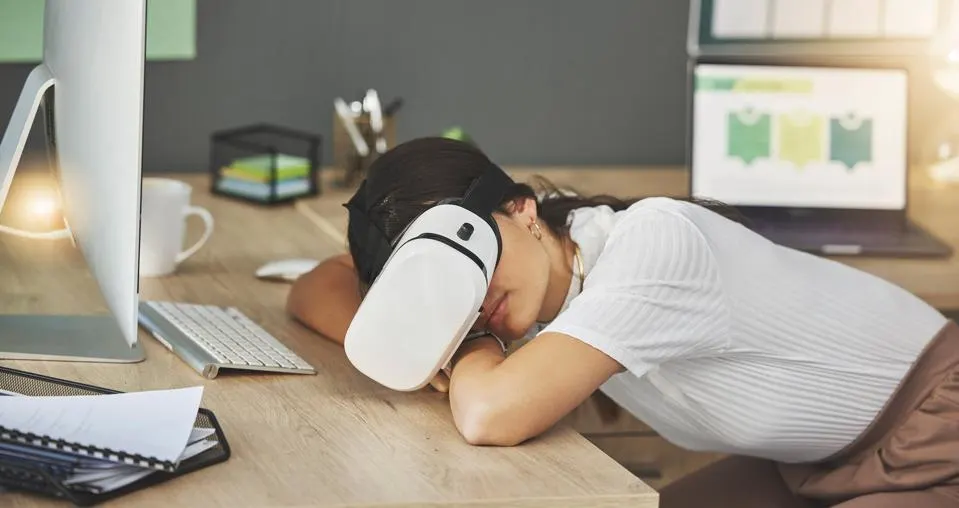
I write a lot about the metaverse, virtual reality, augmented reality, web3 and other advances in the future internet. And there’s one underlying message that’s startlingly clear: as the internet becomes more immersive, the boundaries between the physical world around us and the virtual world are becoming extremely blurred. To the extent that activities we routinely do in the physical world – even activities we think of as distinctly offline – are now incorporating an immersive element. Here are five examples.
Now you can sleep to earn
You might think there’s nothing more offline than sleep. But you’d be wrong. Because the internet is creeping into our real-world slumber.
Perhaps you’ve heard of “play to earn” gaming. Well, now you can sleep to earn. The Sleep City metaverse ecosystem and app is geared around the idea of earning money while you sleep. You simply turn on the app before going to sleep and earn crypto while you catch your ZZZs, with the help of NFT pillows and the app’s SCT crypto token. What the heck is an NFT pillow, you ask? Think of it as in-game accessory like you’d get in Fortnite and you have the right idea. Users can buy, sell, or rent a pillow on the app’s marketplace (there are different kinds of pillows, with different features). And the more an individual participates in the ecosystem – by, say, upgrading their NFT pillows over time – the more rewards they earn while they sleep.
There’s another interesting intersection between sleep and the metaverse: the use of VR to improve sleep. Research shows that, for those people who struggle with sleep, relaxing VR simulations can aid the process of falling asleep and improve the quality of sleep.
Working out in the metaverse
Can’t be bothered to go to a physical, brick-and-mortar gym? But also struggle to motivate yourself to work out at home? Now you can exercise at home, while still enjoying the benefits of going to a gym – such as socializing with others, or getting advice and motivation from a personal trainer.
In fact, we already have metaverse gyms. There’s the aptly named MetaGym, which has virtual trainers who will guide you through your workout. Another example, Gympact, even rewards users for working out, with points that can be spent on avatar goodies, like clothing.
But how does a metaverse workout, well, work? Generally, speaking, you’d access the metaverse gym via a VR headset. You create an avatar to represent you in the virtual space. And you can choose from a variety of exercises and settings – such as working out surrounded by mountains or next to a beautiful lake. In theory, a whole range of metaverse workouts are possible, to mirror whatever you’re doing in the real world – running on a treadmill, riding a stationary bike, rowing on your rowing machine, lifting weights, doing yoga, you name it. In the metaverse, there’ll be a workout to suit your preferences, whatever they are. You can also meet with friends in your virtual gym.
What about eating out or ordering a takeaway?
People think I’m crazy when I talk about metaverse restaurants, but hear me out. Because this is already happening. McDonalds, for example, is planning to create virtual restaurants – true, you won’t be able to eat a Big Mac there, but you will be able to hang out and order food to be delivered to your (real-world) home.
Metaverse technologies may also change the real-world dining experience. With VR and AR, the dining experience can be augmented in a way that enhances the food we’re eating – for example, by transporting us to the majestic forests where the wild mushrooms in our mushroom risotto were foraged.
Such immersive dining experiences are already available. The best known can be found at Sublimotion, which opened on the Spanish island of Ibiza in 2014. (A second Sublimotion restaurant has since opened in Dubai.) Sublimotion is the world’s most expensive restaurant, with meals clocking in at more than $2,000 per head, but it’s also an immersive, multi-sensory, theatrical experience that combines a 20-course fine dining taster menu with art and technology. Digital 360-degree screens surround diners and change throughout the meal, so that each course has its own immersive element. Every surface in the dining room, including the 12-seat dining table, can have images projected onto it.
Imagine the possibilities in the future, as VR and AR hardware becomes smaller, lighter, and more accessible. Not only will we be able to enjoy experiences related to the food we’re eating, we could also choose our own restaurant surroundings.
Going on VR dates
VR could revolutionize the experience of dating online or maintaining a long-distance relationship because, in the metaverse, two people can share a virtual experience, even if they’re thousands of miles apart. VR therefore provides a low-cost – and low-risk – way to meet new people and explore potential love matches. All you need is a VR headset and a dating app that supports virtual experiences.
Indeed, some dating apps are already beginning to incorporate a VR aspect, and I expect more will trial their own VR experiences in the near future. In one example, The League dating app has used VR to provide a “virtual blind date party.” But there’s also Planet Theta, which describes itself as the world’s first VR dating app, where users can meet new people and enjoy immersive experiences like going on a romantic forest walk. Other examples of VR dating services include Nevermet, Flirtual and Second Life’s Lonely Hearts Dating Agency.
I mean, why shouldn’t we go on dates in the metaverse? After all, people already play immersive video games and attend virtual concerts. Going on a date isn’t such a big leap from that. Plus, on a virtual date, we could go anywhere and be anything we wanted. VR dating is also proving to be a safe way for people to experiment with their gender expression and sexual identity.
Sex and the metaverse
Naturally, metaverse technologies offer a way to explore sexuality safely, through highly realistic experiences. This can span anything from augmenting sex in the real world, to having sex in the metaverse with a virtual partner, to enjoying porn in VR. The latter is interesting since it offers a 180-240-degree view of the scene, making the viewer feel like they’re immersed in the scene itself (more so than watching a 2D image) or even participating in the scene. VR porn is becoming so popular that, by 2025, it’s expected to be the third-largest VR sector behind video games and the NFL.
Forbes
Bernard Marr
Jully 21st, 2023


